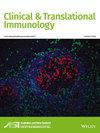Elucidating novel immune profiles for predicting infection in high-risk cohorts: a pilot study in patients with relapsed and refractory chronic lymphocytic leukaemia
Abstract
Objectives
Chronic lymphocytic leukaemia (CLL) patients are at increased risk for infection, with the risk even higher for relapsed and refractory patients. Clinical assessment of infection risk is increasingly challenging in the era of immune-based therapies, such as Bruton's tyrosine kinase inhibitors. A pilot study was conducted to elucidate possible predictive immune markers.
Methods
Patients with relapsed and refractory CLL treated with ibrutinib were evaluated. Peripheral blood mononuclear cells (PBMCs) collected at defined intervals (baseline, 3- and 6 months following commencement of ibrutinib) were analysed, with or without phorbol myristate acetate (PMA)/ionomycin stimulation, using Luminex and RNA sequencing. Luminex and gene expression profiles were compared between patients that who did and did not develop infection to identify immune signatures associated with infection over a subsequent 3-month period.
Results
Twenty-eight patients were included in this pilot study. Forty-six per cent of patients developed an infection (13 patients, 17 events) over 9 months of patient monitoring. Most infections were clinically diagnosed (72.7%) with the remainder microbiologically diagnosed bacterial (18.1%) and viral (9.2%) infections. Cell populations did not correlate with subsequent infection. An inflammatory transcriptome profile at 3 months following ibrutinib was associated with a subsequent infection episode. Increased whole protein response to PMA stimulation at 3 and 6 months was associated with subsequent risk for infections. Increased whole protein response to PMA stimulation was associated with subsequent risk of infection 3 months after commencing ibrutinib.
Conclusion
The combination of protein and RNA analysis can provide further insight into the interactions of immunotherapies and immunity but should be validated further in large cohorts.


 求助内容:
求助内容: 应助结果提醒方式:
应助结果提醒方式:


